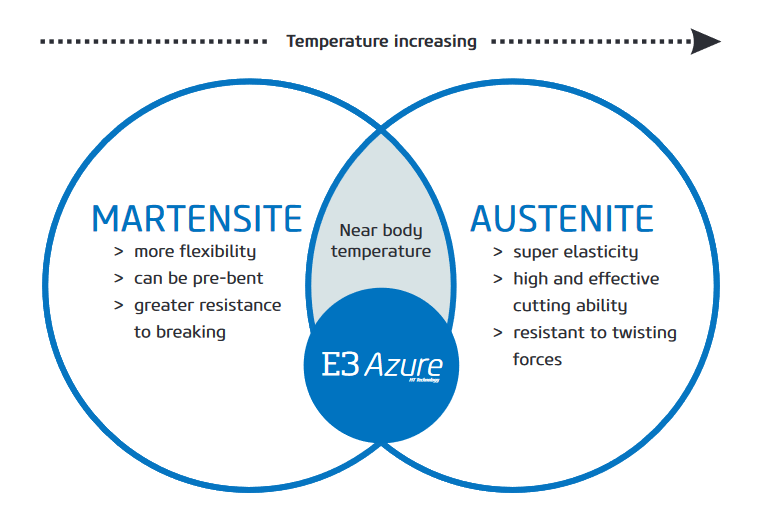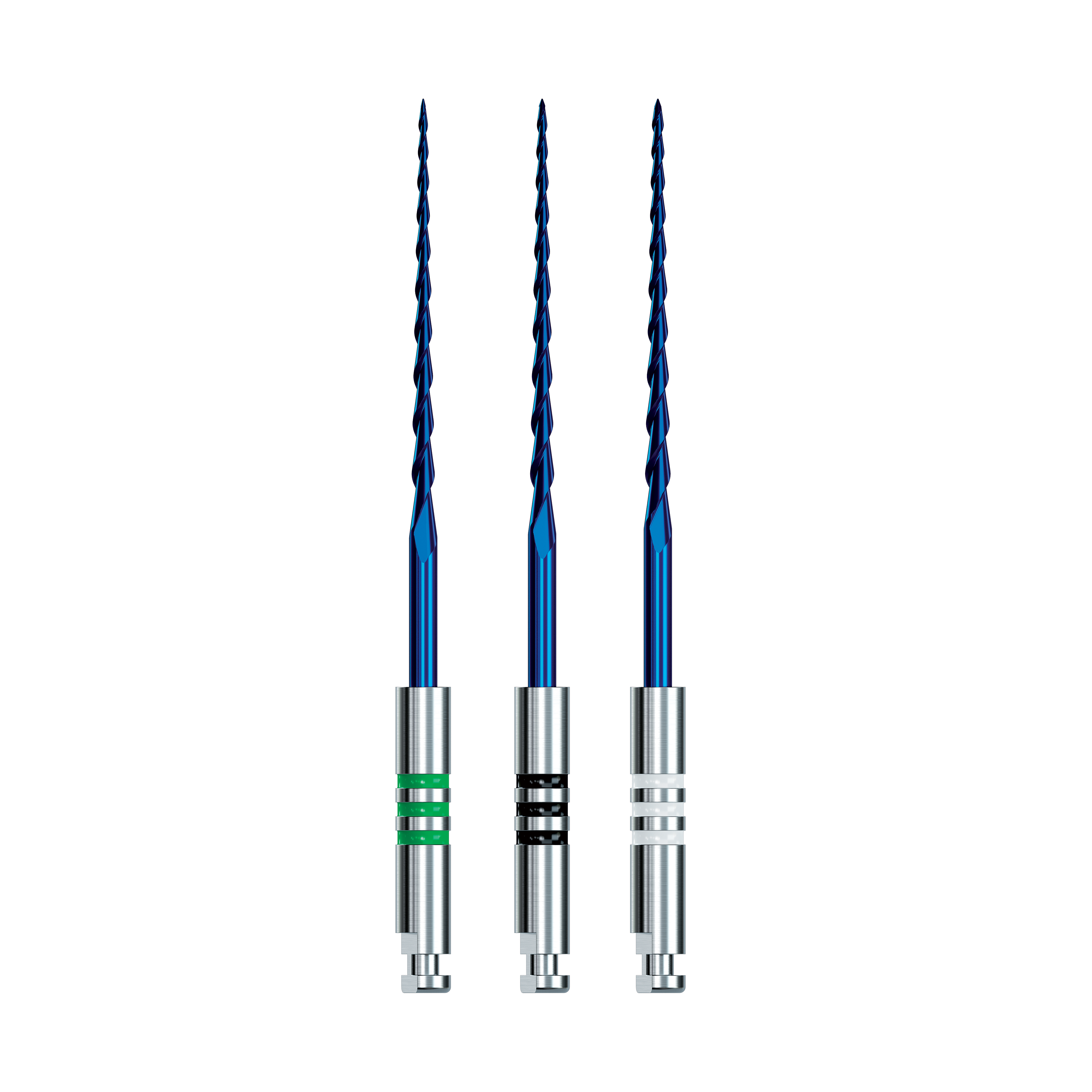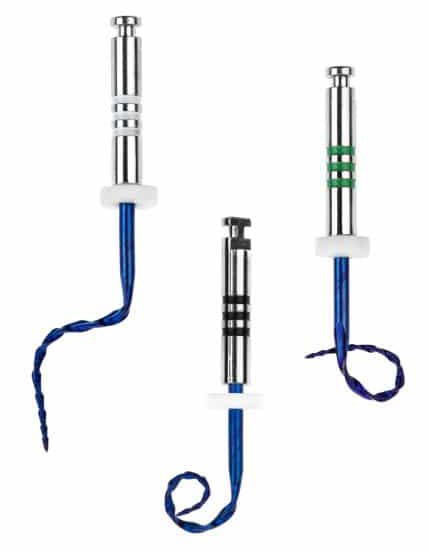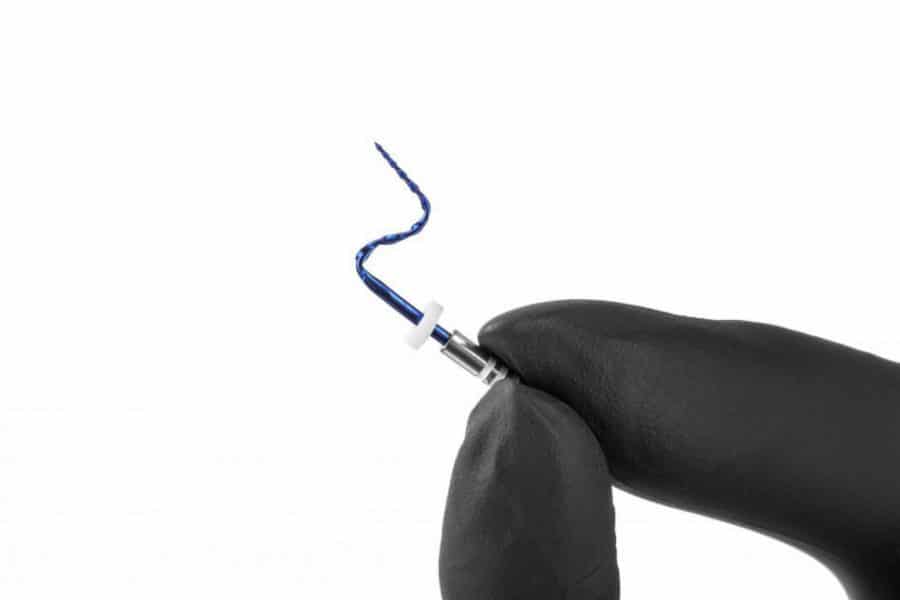
The color of power.
The Azure HT Technology process modifies the crystal structure of the nickel-titanium files. It allows for the martensite to austenite transformation to occur at near body temperature.
This process completely changes the properties of the files. The files can pre-bent before being inserted into the canal. They can easily follow even the most curved canal path, with a minimal risk of perforation, ledges or via falsa.
Feel the significant difference. New and unique….
During root canal treatment (at near body temperature) the file uses the advantages, both of the martensite and austenite phases.
MARTENSITE
- more flexibility
- can be pre-bent
- greater resistance to breaking
AUSTENITE
- super elasticity
- high and effective cutting ability
- resistant to twisting forces

Flexibility
Increased flexibility thanks * to Azure HT Technology
*Internal studies performed according to ISO standards

Resistance
Increased resistance to twisting forces compared to standard rotary instruments.

Do it your way
We aimed at designing a new user-friendly system, which would be flexible, efficient and safe. We had no intention to change doctor’s habits. Endostar E3 Azure was designed for 3 common types of the motion to achieve a perfect root canal preparation. The system is compatible with most of the handpieces
Rotary motion
The instruments rotate clockwise and with a set speed (CW - clock wise).
Reciprocal motion
The instruments perform alternating clockwise (CW) and counter Clockwise (CCW) movements; the angle of clockwise (CW) rotation must be larger than counterclockwise rotation (CCW) e.g. 90 degrees CW and 30 degrees CCW.
Complex motion
Combines the rotary and reciprocal motion. The files rotate until too high resistance in the canal is met. Then the reciprocal mode is activated (CW - CCW, net CW). Rotation mode is turned on again when the resistance returns to acceptable level. An example of complex motion is the OTR mode available in the Endostar Provider endomotor
Endostar E3 Azure Big – instruction of use
- After preparation of the canal with the use of file No. 3 from the set of Endostar E3 Azure Basic is completed, shape the canal with instrument No. 1 from the Endostar E3 Azure Big (04/35) until full working length is reached. Finish with hand NiTi file size 35.
- Insert the file at the working length (vertical movement without rotation). If you feel a slight resistance to the further movement of the file at the working length, this means that the preparation can be finished on size 04/35. If you feel that the file does not encounter resistance at the working length, it is advisable to expand the canal described in point 2.
- Shape the canal by inserting instrument No. 2 (04/40) at full working length. Finish with hand NiTi file size 40. Insert the file at the working length (vertical movement without rotation). If you feel a slight resistance to the further movement of the file at the working length, this means that the preparation can be finished on size 04/40. If you feel that the file does not encounter resistance at the working length, it is advisable to expand the canal described in point 3.
- Shape the canal using instrument No. 3 from the Endostar E3 Azure Big (04/45) until you reach full working length. Finish with hand NiTi file size 45. Insert the file at the working length (vertical movement without rotation). If you feel a slight resistance to the further movement of the file at the working length, this means that the preparation can be finished on size 04/45. If you feel that the file does not encounter resistance at the working length, it is advisable to expand the canal larger-sized NiTi hand files such as size 50, 55, 60 etc.


Azure HT Technology
An innovative system created with Azure HT Technology.

Sterilization
Autoclave in 134 degrees. Recommended sterilization time: 3 minutes at 2.1 bar overpressure.

Nickel-titanium alloy

CE mark
Endostar E3 Azure instruments can be repeatedly sterilized and used, provided that the visual inspection performed by the dentist prior to use shows that the instrument remains undamaged, is not bent, deformed, does not show signs of blade wear and can be securely attached to the handpiece. Particular attention should be paid to the winding (or excessive twisting) of the windings of the file.
The instrument windings should be regularly spread over the entire length of the blade, if in one point of the blade the windings are too close or too far apart (there is no regularity in the windings growth of the unused instrument), this is a sign that the instrument could break in the canal.
Permanent deformations of the instrument, especially bends, which do not have the form of an arc and have a visible break point should be always controlled before re-use. The heat-treated NiTi alloy allows these instruments to bend in the form of an arc.
In case of doubt, the file can be placed in any environment (fluid, air) at a temperature slightly above 40⁰C for a few seconds, then the blade should be straightened or curved on a very smooth arc. If the file is still deformed, it means it is permanently deformed and could not be use again. After each use, check that the blade is securely placed in the file grip. If the file has been subjected to high torsion force, especially in highly curved canals the instrument should be used only once.
Dispose of file which appears to be defective.
Files in the package may vary slightly in color, and the blades may be slightly arched. These differences do not affect the quality of the product. They are result from the applied heat treatment.

Files should be used with motor speed at 300 rpm.
The torque settings indicated in the table above table are for example only and may vary according to each user preferences and motor capabilities. Do not exceed the upper torque limit which is different for each instrument. If precise torque settings cannot be set, and only manufacturer-specific torque levels are available, be sure to select one that does not exceed the recommended limit.
File
Number of strips
Taper (%)
ISO
Lenght
Nr 1
3
04
35
21 / 25 / 29 mm
Nr 2
3
04
40
21 / 25 / 29 mm
Nr 3
3
04
45
21 / 25 / 29 mm
Endostar E3 Azure Big
Intro kit, 35/04, 40/04, 45/04, 3 pcs. 21 mm
E3AZB21
Intro kit 35/04, 40/04, 45/04, 3 pcs. 25 mm
E3AZB25
Intro kit, 35/04, 40/04, 45/04, 3 pcs. 29 mm
E3AZB29
Endostar E3 Azure Big
Refill, 35/04, 6 pcs., 21 mm
E3AZ350421
Refill, 35/04, 6 pcs,. 25 mm
E3AZ350425
Refill, 35/04, 6 pcs., 29 mm
E3AZ350429
Refill, 40/04, 6 pcs., 21 mm
E3AZ400421
Refill, 40/04, 6 pcs., 25 mm
E3AZ400425
Refill, 40/04, 6 pcs., 29 mm
E3AZ400429
Refill, 45/04, 6 pcs., 21 mm
E3AZ450521
Refill, 45/04, 6 pcs., 25 mm
E3AZ450425
Refill, 45/04, 6 pcs., 29 mm
E3AZ450429
Files to download:
Brochure - Endostar E3 Azure
Download
Brochure - Endostar E3 Azure RU
Download
Brochure - Endostar E3 Azure SK
Download
Brochure - Endostar E3 Azure ES
Download
Brochure - Endostar E3 Azure FR
Download
Instruction for use - Endostar E3 Azure EN
Download
Instruction for use - Endostar E3 Azure PL, EN, RU, FR, ES, UA
Download
Instruction for use - Endostar E3 Azure PL
Download
Instruction for use - Endostar E3 Azure RU
Download
Instruction foruse - Endostar E3 Azure UA
Download
Instruction for use - Endostar E3 Azure ES
Download
Instruction for use - Endostar E3 Azure FR
Download
Instruction for use - Endostar E3 Azure CZ
Download
Recommended number of usage of instruments for root canal treatment
Download
Instructions for cleaning, disinfecting and sterilizing instruments
Download
Szeroka gama
produktów do endodoncji
Wybierz najlepsze rozwiązanie i wyjdź naprzeciw oczekiwaniom klientów.
Products





